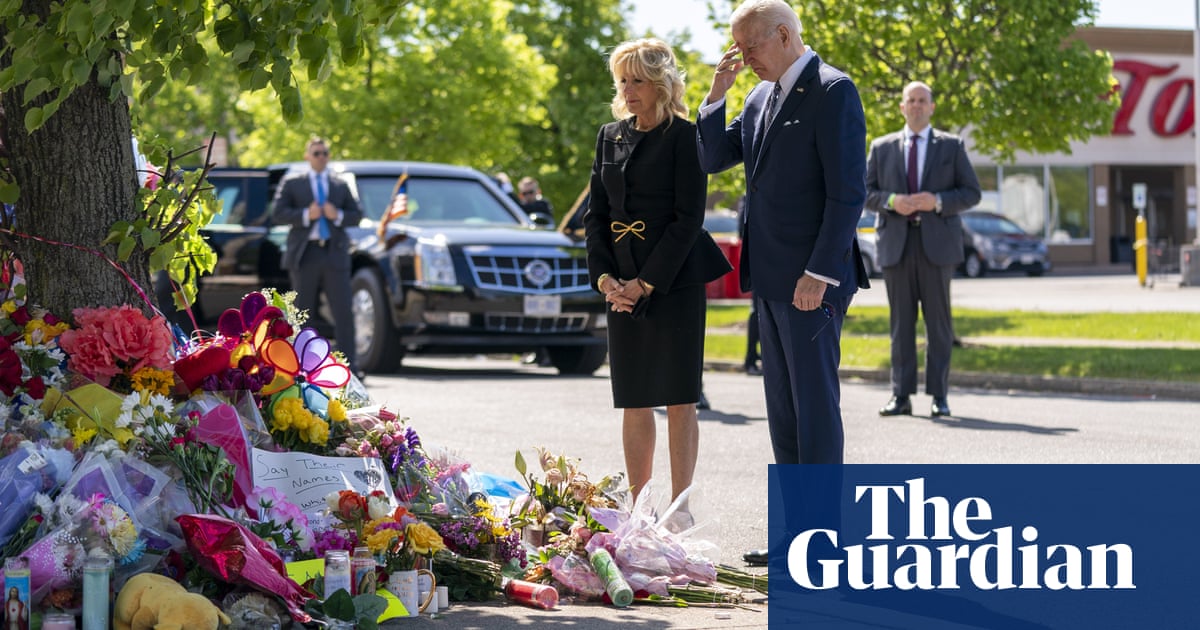
Show caption President Joe Biden and first lady Jill Biden visit the scene of a shooting at a Buffalo supermarket on Tuesday. Footage of the racist attack has spread inside New Zealand despite efforts to ban it. Photograph: Andrew Harnik/AP Buffalo shooting Buffalo shooting: unease in New Zealand as live stream of ‘Christchurch-inspired’ attack finds foothold Researchers find New Zealand has become a fertile ground for extreme material amid efforts to ban alleged shooter’s ‘manifesto’ Tess McClure in Auckland @tessairini Wed 18 May 2022 01.54 BST Share on Facebook
Share on Twitter
Share via Email
Widespread horror at the killing of shoppers at a Buffalo grocery store, allegedly by a white supremacist gunman, has been felt keenly in New Zealand as it continues to reckon with the ripple effects of the 2019 Christchurch massacre of 51 Muslims at prayer.
New Zealand has already moved to ban the live stream video and “manifesto” apparently published by the alleged shooter, which is said to specifically cite the mosque shootings as a source of inspiration. Mosque attack survivors are being re-traumatised by the Buffalo footage, reportedly sent to them anonymously online, and researchers are concerned material from the shooting is spreading quickly inside New Zealand.
The ban makes it illegal to possess or distribute the documents – which authorities say are a close imitation of those published by the Christchurch gunman.
The document states that the alleged killer was “inspired by the March 15 mosque killer”, New Zealand acting chief censor Rupert Ablett-Hampson said, announcing the ban. “It has become a trend for terrorists, in particular white supremacist killers, to issue these kinds of publications to encourage others to follow their lead.”
For the survivors of the attack in New Zealand, the news out of New York brought shock and distress – as well as reports that anonymous online actors were targeting and re-traumatising survivors by sending them streamed footage of the Buffalo attacks.
Gamal Fouda, imam of al-Noor mosque, where the Christchurch attack took place, said in a statement posted to social media that he was “devastated by this terror attack in USA”.
“My heart goes out to the people impacted by this heinous attack. Social media companies must stop people from using them as a platform for spreading hate,” he said.
A memorial is seen in the wake of a weekend shooting at a Tops supermarket in Buffalo, New York. Photograph: Brendan McDermid/Reuters
Fouda also shared a Stuff news report that the mosque shooting’s survivors were being targeted by anonymous online profiles sending them footage of the Buffalo shooting, thanking those who had reported it to the authorities. “Thank you for those who reported this hateful and violent misbehaviour,” he said. “There is no place for that kind of hateful ideology in New Zealand.”
Stuff reported that at least three Christchurch survivors, who remained anonymous, had been sent footage of the Buffalo shootings. A police spokesperson would not comment on whether they had received complaints, but said they were “aware that objectionable material relating to the shooting in Buffalo, New York, is circulating online” and “charges may be considered if people within New Zealand are found to possess or share these materials”.
Within New Zealand, researchers are concerned about the spread of copies of the alleged Buffalo terrorist’s propaganda, and say the country has developed fertile ground for extreme material among the pandemic era’s conspiratorial and anti-authoritarian movements.
Dr Sanjana Hattotuwa, who studies disinformation and fringe online communities for Te Punaha Matatini research centre, said the researchers had observed the Buffalo live stream video and propaganda material spreading extensively within New Zealand groups they monitored.
While it’s impossible to track the true number if people who have viewed the material on platforms such as Telegram, Hattotuwa said that New Zealand’s fringe and misinformation-spreading ecosystems had grown dramatically since the Christchurch attacks in 2019. Anti-vaccine factions had intermingled with far right and Q-Anon groups, and developed new, conspiratorial and extreme communities, typically hosted on Telegram. Within those groups, the Buffalo material was already spreading, he said, with several accounts that appeared to be expressly set up to disseminate the video and so-called manifesto.
“The anti-vax landscape[s are the] ones who are front and centre, distributing, propagating and amplifying this content – that’s an entirely new phenomena that wasn’t there in March 2019,” he said.
Many of the groups sharing the Buffalo material online were not directly glorifying it, Hattotuwa said – some believe it was a “false flag” or “distraction” set up by elites to divert attention. But he had concerns that its propagation meant it could spread to audiences who were receptive to radicalisation.
“It doesn’t glorify it, but it doesn’t also push back on it. It normalises [the violence] as something that is … inevitable”.
Ablett-Hampson told the Guardian that while the censor’s office had banned the alleged shooter’s specific manifesto, there was a variety of material surrounding it that did not reach New Zealand’s legal thresholds for a ban. “The other challenge is the underlying reasoning and rationale that this form of hate crime is based on. A lot of the recent attacks are based on that concept of “great replacement” theory and the disinformation that is built around that. I don’t have any power to classify a lot of [that material],” he said.
“Those are very challenging issues for enforcement agencies – and I don’t think that’s just New Zealand.”








